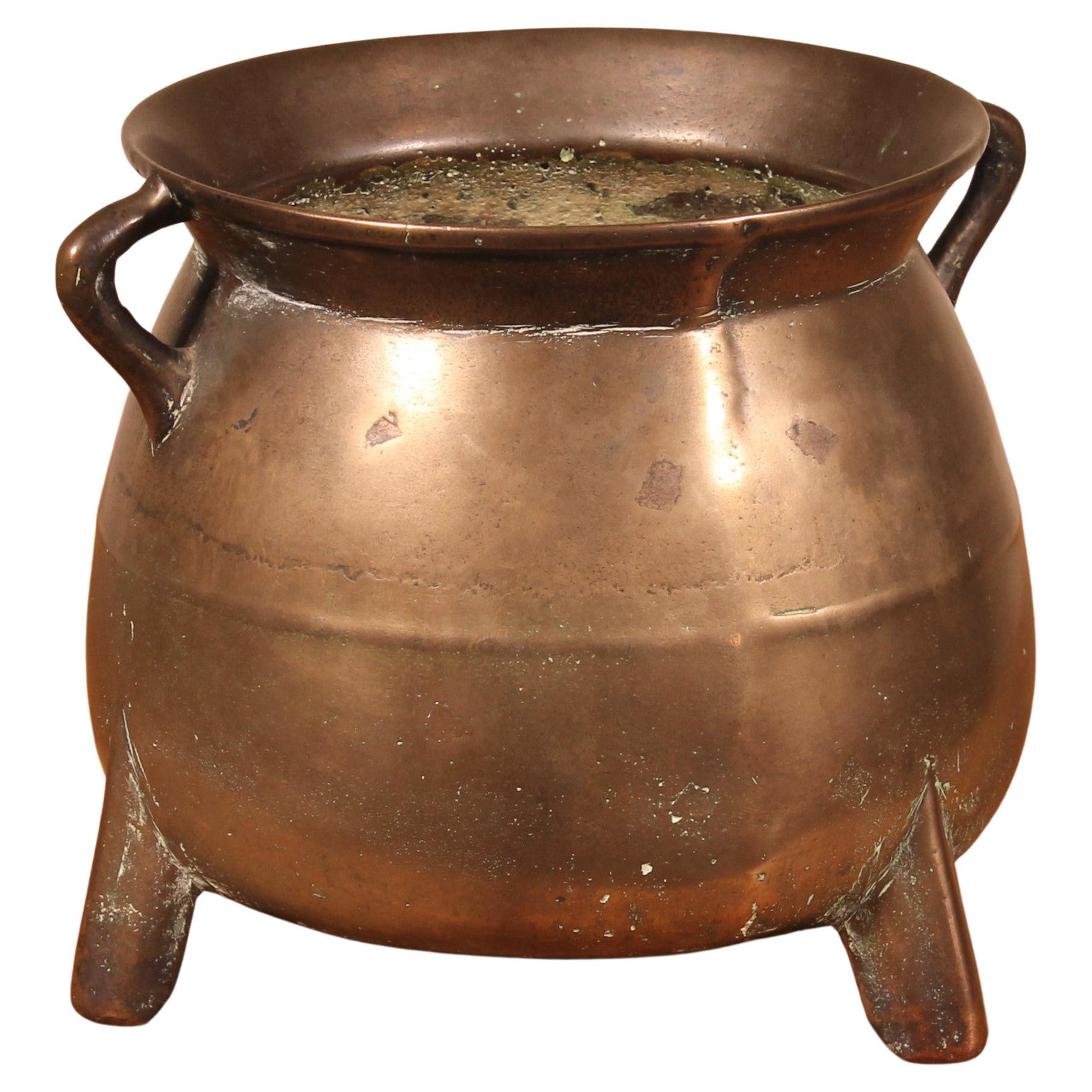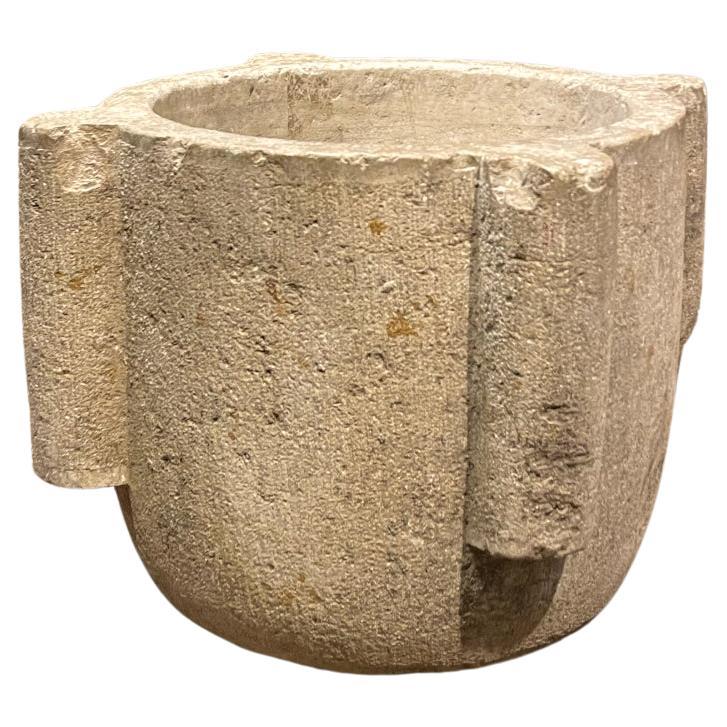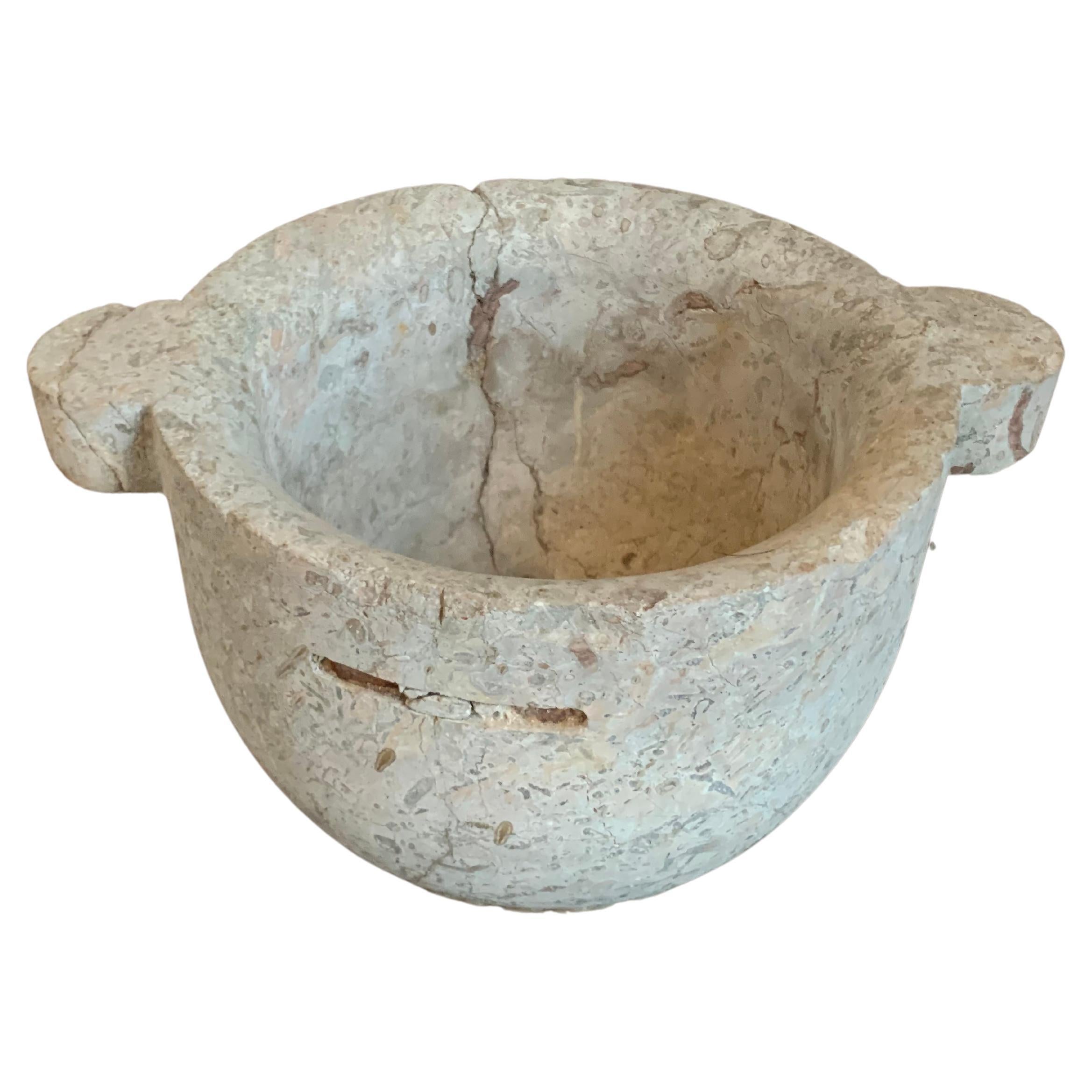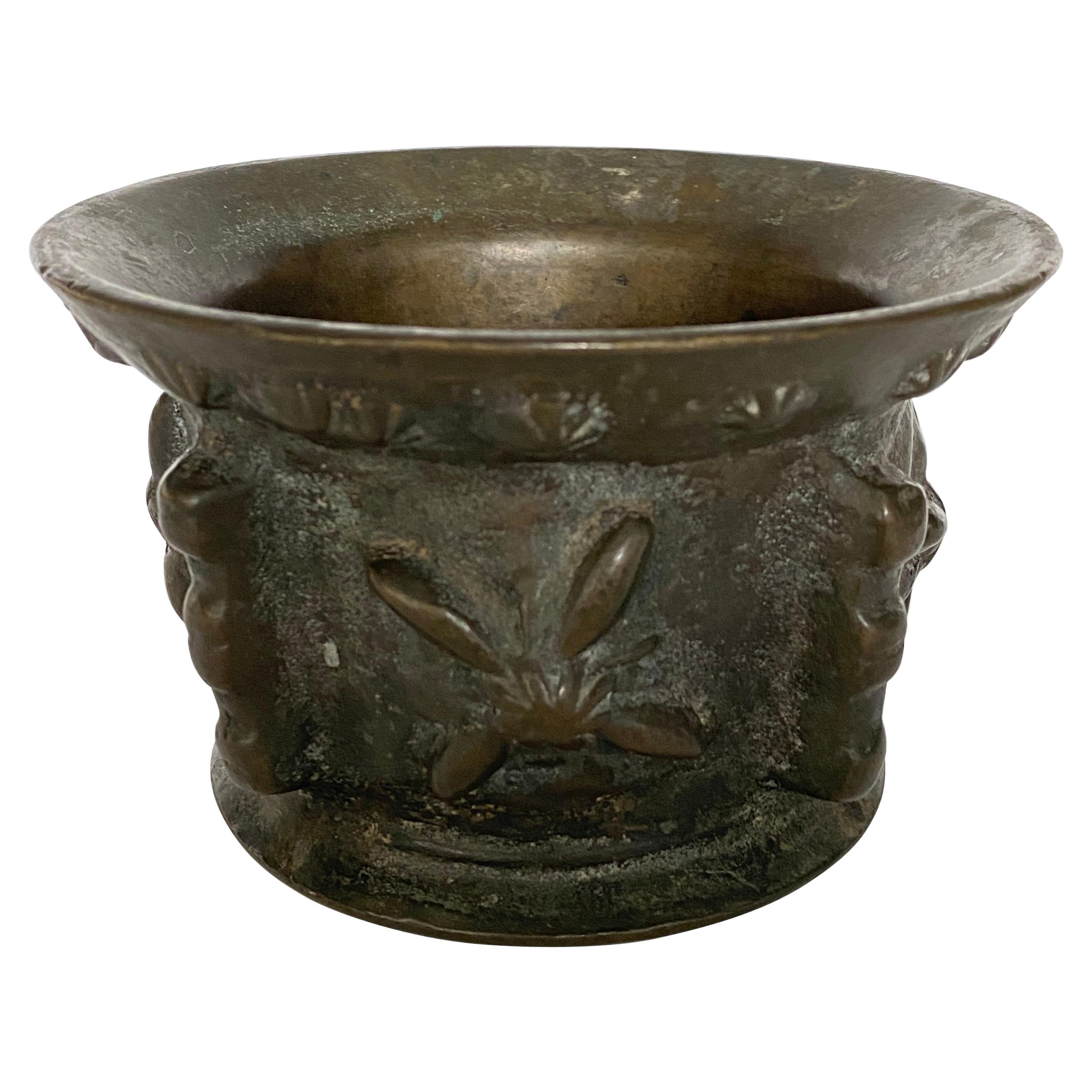Items Similar to Heavy 16th Century French Bronze Mortar with Handles, Dated 1587, 109 lbs
Want more images or videos?
Request additional images or videos from the seller
1 of 13
Heavy 16th Century French Bronze Mortar with Handles, Dated 1587, 109 lbs
About the Item
A large and heavy (it weighs 109 lbs!) example of a traditional French pharmacy bowl, this bronze mortar with handles is from 1587, as seen on the production date beneath the molded rim. There is also a maker’s mark on the main body, between two of the numerous protruding ridges that embellish the heavily verdigris metal. Flanking the mark is a pair of scrolled handles, each wrapped in a curled leaf.
Often made of durable materials, such as stone or marble, mortars were designed to withstand the grinding of the pestle. In France, they were used in the kitchens of grand chateaux. They were also used in apothecaries by pharmacists to crush the herbs into powder for medicinal purposes. Today, most savvy collectors utilize mortars as decorative bowls in various rooms of the house.
- Dimensions:Height: 10.5 in (26.67 cm)Diameter: 14 in (35.56 cm)
- Style:Renaissance (Of the Period)
- Materials and Techniques:
- Place of Origin:
- Period:
- Date of Manufacture:1587
- Condition:Wear consistent with age and use. Minor losses. Very good antique condition, with minor losses to the rim and some indentations. Light rubs and age separations to the interior. Does not include a pestle.
- Seller Location:Dallas, TX
- Reference Number:
About the Seller
5.0
Platinum Seller
These expertly vetted sellers are 1stDibs' most experienced sellers and are rated highest by our customers.
Established in 1983
1stDibs seller since 2011
736 sales on 1stDibs
Typical response time: <1 hour
- ShippingRetrieving quote...Ships From: Dallas, TX
- Return PolicyA return for this item may be initiated within 2 days of delivery.
More From This SellerView All
- Small 19th Century French Bronze Mortar with PestleLocated in Dallas, TXThis small bronze mortar and pestle are from 19th century France. The outside of the mortar has been adorned with mascarons and geometric patterns that rise from chased sides. The pe...Category
Antique 19th Century French Decorative Bowls
MaterialsBronze
- Antique French Marble Mortar with Pestle, 19th CenturyLocated in Dallas, TXDuring antiquity, mortars and pestles were used to grind up herbs for cooking or by pharmacists to make medicinal powders. They are typically constructed from a hardened substance, s...Category
Antique 19th Century French Decorative Bowls
MaterialsStone, Marble
- 17th Century Granite Rose Mortar from Brittany, FranceLocated in Dallas, TXThis granite rose mortar was hand-carved in Northern Brittany, France during the 1600’s. Granite is formed when magma is cooled underground, which causes various minerals to become e...Category
Antique 17th Century French Decorative Bowls
MaterialsGranite
- Antique Deep Black Marble Mortar from France, 19th CenturyLocated in Dallas, TXAlthough the earliest mortars and pestles were utilized for cooking during the Stone Age, in more recent centuries they were employed by pharmacists to grind herbs into powder for medicinal purposes. They were almost always constructed from a hardened substance, such as this 19th century French marble mortar. The deep black...Category
Antique 19th Century French Decorative Bowls
MaterialsStone, Marble
- Circa 1800 French Marble Mortar with Wooden PestleLocated in Dallas, TXThis very old carved marble mortar and wooden pestle dates to circa 1800 and originally came from France. The original use of a mortar and pestle was to ...Category
Antique Early 1800s French Decorative Bowls
MaterialsMarble
- Small French Bronze Mortar and Pestle with Fleur De Lys and Crown, Circa 1700Located in Dallas, TXThis small bronze mortar and pestle are from France, circa 1700. The circular opening has several layers of molding, with the bottom three interrupted by a pair of open crowns on opp...Category
Antique Early 1700s French Louis XIV Decorative Bowls
MaterialsBronze
You May Also Like
- Bronze Mortar, Tuscany, Second Half of 16th CenturyLocated in Bruxelles, BEBronze mortar with garlands, flowers and putti - Tuscany , second half of 17th century. Measures: height 10 diameter : 13 cm Artisans and healers used mortars for grinding food...Category
Antique 16th Century Italian Renaissance Scientific Instruments
MaterialsBronze
- Bronze Pot, 16th CenturyLocated in Brussels, BrusselsSuperb Flemish Renaissance bronze pot from the 16th century. Superb patina and in very good condition.Category
Antique 16th Century Belgian Renaissance Decorative Bowls
MaterialsBronze
- 16th Century Spanish White Stone MortarLocated in BARCELONA, ESEmbark on a gastronomic journey through time with our unparalleled culinary treasure, the Exquisite 16th Century Spanish White Stone Mortar. This ...Category
Antique 16th Century Spanish Decorative Bowls
MaterialsStone
- Grey Marble Mortar High Period circa 16thLocated in Beuzevillette, FRAntique large marble mortar of the high period. Dating from the late Middle Ages, early Renaissance. This mortar is made of grey marble. The morta...Category
Antique 15th Century and Earlier French Jars
MaterialsMarble
- 16th Century Spanish Cast Bronze Apothecary MortarLocated in Kensington, MDThis rare example of a Renaissance bronze mortar is decorated with starbursts all along the everted rim and features 4 large starbursts on the sides between the ribbed handles. The c...Category
Antique 16th Century Italian Renaissance Urns
MaterialsBronze
- Brazier, Copper, Possibly Castile, 16th CenturyLocated in Madrid, ESBrazier. Copper. Possibly Castile, 16th century. Brazier made of copper with a circular foot decorated with vertical bands, a low tubular shaft enhanced with a fine roped molding and a semicircular body, with a wide mouth that flares outwards, and two halfrectangle-shaped metal handles with a torso part on the sides. Of the piece. These types of pieces were used both in civil and ecclesiastical interiors with the aim of heating the occupants of the room as much as possible, and their conservation is rare because they are utilitarian elements that were discarded over time or due to be damaged They used to be objects destined for the upper class, and followed the same typologies whether they were destined for a sacristy or a private residence. This case, possibly intended for use in the sacristy, shows a typical typology in the Spanish school of the time. Compare, for example, with the brazier present in The Birth of the Virgin Mary of the Altarpiece assembled around 1520 by Pedro de Guadalupe from Valladolid and found in the church of San Esteban...Category
Antique 16th Century Spanish Renaissance Fireplaces and Mantels
MaterialsCopper, Other
Recently Viewed
View AllMore Ways To Browse
Murano Gold And White Bowl
Red Murano Glass Dish
Mid Century Bowls And Centerpieces
Margiela 13
Rare Murano Bowl
English Labrador
Gothic Altar Crucifix
Kurt 55
Metal Bath Vanity
Michel Cadestin Karate Chair
670 First
Antique Table Lamps Base Materials 1940
Berlino Dining
Blue Red Bedding
Charlotte Chair Company Mahogany
Electra Giuliana
Gold Velvet Settee
Ib Kofod Larsen Teak Dining Table





